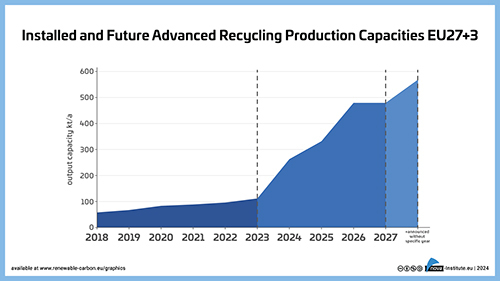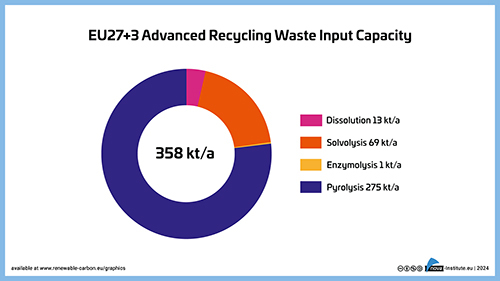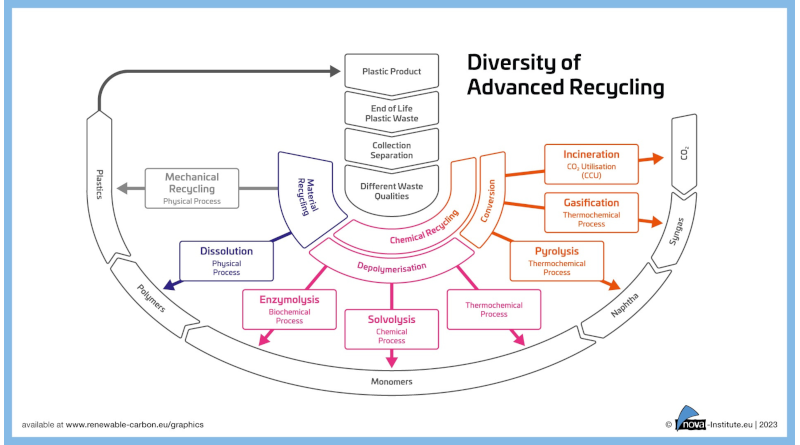Advanced recycling technologies to complement mechanical recycling
Advanced recycling on the rise
Advanced recycling technologies are developing at a fast pace, with new players constantly appearing on the market, from start-ups to chemistry giants and everything in-between. New plants are being built, new capacities are being achieved, and new partnerships are being established. With all these dynamic developments, it is difficult to keep track of what is happening. Nova Institute’s report “Mapping of advanced plastic waste recycling technologies and their global capacities” aims to clear up this jungle of information providing a structured overview and in-depth insight.
Besides conventional mechanical recycling and taking account of recent discussions on the improvement of recycling rates, a wide spectrum of advanced recycling technologies is moving into focus. Whilst PET bottle mechanical recycling is well established and performing well, in cases of mixed plastic waste or mixed waste containing various plastics and organic waste, mechanical recycling is not an option, or allows only partial solutions with considerable effort of pre-treatment. In consequence, these waste streams mostly end up in landfill or incineration instead of being further processed into a new feedstock. This is why advanced recycling technologies are crucial for the circular economy.

With advanced recycling a toolbox of versatile technologies is available to address plastic waste streams in different compositions and qualities in order to transform them into a range of different raw materials that can be reintroduced at different positions along the value chain of polymers and plastics. The technologies include material recycling based on dissolution (physical process) from which polymers can be obtained. Furthermore, numerous chemical recycling technologies are available that are capable of depolymerising a targeted polymer into its component parts (monomers) via enzymolysis (biochemical process), solvolysis (chemical process), and thermal depolymerisation (thermochemical process).
Another group of chemical recycling technologies are thermochemical processes which are currently achieving the largest capacities. These technologies are based on pyrolysis, gasification and incineration coupled with Carbon Capture and Utilisation (CCU) which are capable of converting plastic waste into secondary valuable chemicals as well as naphtha, syngas, and CO2 which can be used as feedstock for the production of new polymers.
Which technologies are suitable for PET?
The Nova Institute report “Mapping of advanced plastic waste recycling technologies and their global capacities” provides an in-depth insight into advanced recycling technologies and their providers. More than 100 technologies and their status are presented in detail listing the companies, their strategies and investment as well as cooperation partners. But which technologies are actually suitable for PET?
Solvolysis
The solvent-based solvolysis describes a chemical process based on depolymerisation which can be achieved with different solvents. This process breaks down polymers (mainly PET) into their building units (e.g. monomers, dimers, oligomers). After breakdown, the building units need to be cleaned from the other plastic components (e.g. additives, pigments, fillers, non-targeted polymers). After cleaning, the component parts are polymerised to synthesise new polymers. With only 24 companies involved, fewer solvolysis technology providers are on the market compared to pyrolysis which likewise offers smaller capacities, typically between 550-8,750 t/a. Of the identified solvolysis technology providers a majority are located in Europe (14 providers) followed by North America (seven), Japan (two), and China (one provider). In the case of nine companies, the majority of providers are mainly small enterprises. Large providers consist of seven companies, whilst five are medium scale and two are micro/start-up enterprises. Among the large enterprises are Aquafil (Arco, Trentino, Italy, Eastman Chemical Company (Kingsport, TN, USA), IFP Energies Nouvelles (IFPEN) (Rueil-Malmaison, France), International Business Machines Corporation (IBM) (Armonk, NY, USA), DuPont Teijin Films (Tokyo, Japan), and Dow (Midland, MI, USA).
Dissolution
Dissolution describes a solvent-based technology that is based on physical processes. Targeted polymers from mixed plastic wastes can be dissolved in a suitable solvent, leaving the chemical structure of the polymer intact. Dissolution is suitable for PET, but most suppliers primarily focus on PP/PE. However, where high PET content is desired, solutions for PET are available. Other plastic components (e.g. additives, pigments, fillers, non-targeted polymers) remain undissolved and can be cleaned from the dissolved target polymer. Afterwards an anti-solvent is added to initiate the precipitation of the target polymer. The polymer can be obtained directly, and in contrast to solvolysis, no polymerisation step is needed. Currently, the process is achieving a maximum capacity of 8,000 t/a; the majority of the nine identified technology providers is located in Europe (four providers), followed by North America (three), China (one), and the rest of the world (one provider). In the case of three of the companies, most are small enterprises followed by micro/start-up- (two companies), medium- (two companies), and a large (two companies) enterprise which is represented by Shuye Environmental Technology (Shantou, China).
Enzymolysis
An alternative path is represented by enzymolysis, a technology based on biochemical processes utilising different kinds of biocatalysts to depolymerise a polymer into its building units. Being in an early development phase, this technology is available only at lab-scale. Currently, only one enzymolysis technology provider was identified which is a small enterprise located in Europe. The process is suitable for PET.
Gasification
Another thermochemical process that is suitable for PET and capable of converting mixed plastics waste and biomass in presence of heat and oxygen into syngas and CO2 is gasification. Overall, 12 gasification technology providers were identified and currently the largest achieved capacity measure is of up to 200,000 t/a; most providers are located in North America (seven providers) followed by Europe (five). The majority of the identified companies (four) are medium-sized enterprises, followed by small- (three companies), micro/start-up (two companies), with just one large enterprise (Eastman).
Pyrolysis

In the pyrolysis process, a thermochemical recycling process is available that converts or depolymerises mixed plastic wastes (mainly polyolefins) and biomass into liquids, solids, and gases in the presence of heat and the absence of oxygen. Obtained products range, for example, from various different fractions of liquids including oils, diesel, naphtha, and monomers as well as syngas, char, to waxes. Depending on the obtained products these can be utilised as renewable feedstocks for the production of new polymers. With 40,000 t/a, the second-largest capacity found in the report is achieved with pyrolysis.
The majority of the 80 identified technology providers are located in Europe (42 providers) followed by North America (21), rest of the world (11), China (four), Cis (one), and Japan (one provider). With 27 companies most providers are small enterprises followed by micro/start-up- and medium- enterprises (both each comprising 18 companies), and large enterprises (16 providers) such as Blue Alp (Eindhoven, the Netherlands), Demont (Millesimo, Italy), Ineos Styrolution (Frankfurt, Germany), Neste (Espoo, Finland), Österreichische Mineralölverwaltung (OMV) (Vienna, Austria), Repsol (Madrid, Spain), Unipetrol (Prague, Czechia), VTT (Espoo, Finland), and Chevron Phillips (The Woodlands, TX, USA).
In Europe, pyrolysis is the predominant form of chemical recycling for PE/PP. However, for PET, the process is only suitable to a limited extent of <5%.
Evaluation of capacities
More than 340 planned as well as installed and operating plants were mapped worldwide providing a total input capacity of 1,477 kt/a. In Europe, there is already a considerable potential of know-how and providers for chemical and physical recycling technologies which is reflected in the comparison with the globally installed plants and capacities. From all installed chemical and physical recycling plants worldwide more than 60 and thus the majority are operating in Europe covering nearly one quarter of the worldwide input capacity. Europe therefore ranks top in the global comparison chart.
Globally, the production capacity of advanced recycling is 1,082 kt/a with products ranging from polymers, monomers, naphtha, Secondary Valuable Chemicals (SVC), and fuels & energy. Europe’s circular strategy becomes evident by putting the product shares of polymers, monomers, naphtha, and SVC from chemical and physical recycling into a global context. Here, Europe covers 36 % of the installed global capacity.
In the coming five years a strong growth of the market is expected in which the amount of installed chemical and physical recycling plants will steadily grow. A first indicator are the announcements of the technology providers for the construction of new plants. An analysis of these announcements shows that the input capacity in Europe will more than triple by 2027 while globally the capacity will double. However, the projection for Europe might change depending on any additional political measures, such as the revision of relevant directives or the establishment of incentives and investment programmes.

